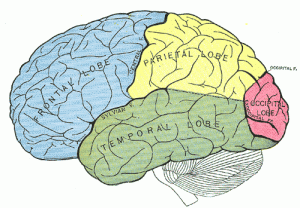DIY: Bed Crocheted From Sweaters Strips
Before you get rid those out-of-style sweaters you’ve been holding onto, consider making them into a snuggly bed for your pet.  One way is to make a pet bed by crocheting strips of old sweaters. Pick colors that look good together—that awful 1980’s mustard yellow should probably be avoided.  Visit a thrift store if you’re short on old sweaters.  Or if you only have ones that are mustard yellow.  No really.
Socializing = Bigger Brains For Dogs
 The existing coverage of this study from Oxford is one reason I write this blog. Â Most media outlets are stating this study proves dogs are smarter than cats (dumb) and they’re including polls for you to vote on whether you agree (dumber).
The existing coverage of this study from Oxford is one reason I write this blog. Â Most media outlets are stating this study proves dogs are smarter than cats (dumb) and they’re including polls for you to vote on whether you agree (dumber).
Update: Yea! Â Sophia Yin over at Huffington Post writes a smart article on the study.
The study actually shows something I think is much more interesting. Socializing led to bigger brains in some mammals. The brains of mammals that live in groups like monkeys, horses, dolphins, camels, & dogs grew the most over time, while the brains of  more solitary mammals like cats, rhinos, & deer grew much more slowly.  Scientists previously believed that brain size had increased at relatively the same rate across species.  Being a social being requires enough extra work that brains actually increased in size.
So, the study does show that dog brains have increased in size more dramatically that cats, but for reporters to say dogs are smarter than cats is meaningless. Â Smarter how? Â About catching prey? Â Avoiding detection? Â Getting humans to do what they want? Â Surviving alone? Â It annoys me that reporters dumb down studies and reduce them to some stupid poll that doesn’t mean anything. Â So one of the reasons I write this blog? Â I think you (& I) are smarter than that.
Science News Bites: Shaking, Collars, Drinking
- Dog shake physics—wet animals are so efficient at shaking water out of their fur, it probably has mechanical applications with washing machines, spin coaters, painting devices, etc.
- Cat collars safer than previously thought. Lost cats are much less likely to be found than lost dogs, so researchers wanted to see how well cats would tolerate a collar & just how dangerous. Â In one city surveyed, 40% of lost cats were indoor-only cats and fewer than 2% of lost cats are reunited with their owners, so indoor cats need collars with tags too. Â In terms of safety, the study reported that out of 391 cats, only 18 cats got their collar stuck in their mouth, a limb, or another object.
- Cats are masters of hydrodynamics. Cats average 4 laps per second without getting their chin or whiskers wet.  A column of water forms between the tongue and the surface of the liquid.  Dogs’ tongues scoop up water, while cats’ tongues don’t break the surface.  One of the researchers got the idea after watching his own cat drink milk.
DIY: Cat Toys From Felt Sushi Tutorial & Pattern
Felt sushi are perfect for kitties!  With a couple of modifications, this tutorial for felt sushi will make some awesome cat toys that would be fun gifts for the holidays.  One thing I’d change is instead of beads for the tobiko, use french knots with orange embroidery floss. They’ll still look good and will be safer.  And don’t forget to add some good catnip!




